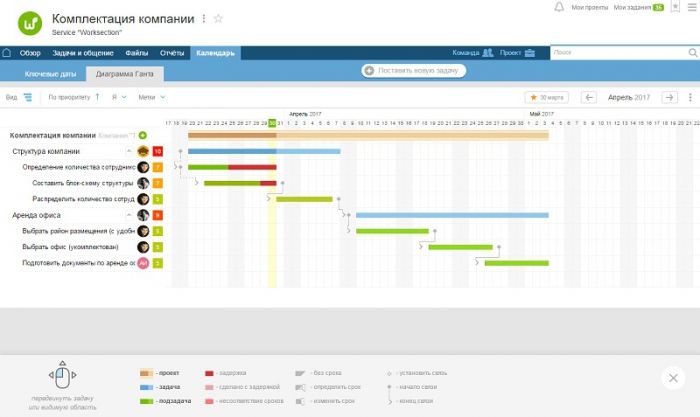How to write a project management plan correctly?
Planning is the foundation on which any project is built. And the stronger it is, the more likely the project will be successful. For this, there is a project management plan, consisting of three blocks: activities (goals, project concepts, resource assignments, etc.), tasks and resources (people, equipment, money, etc.).
What is a project management plan?
A project management plan is a document in which all elements of a project are spelled out: from activities and resources to criteria for assessing success and risks. In developing this plan, the project manager tries to cover the entire project, from initiation to closure.
The project management plan is the most important document when creating a project - at the level of stakeholder involvement. Just as a project cannot be implemented without the participation of a stakeholder, so without a well-thought-out management plan, the project will fail. Documents such as a plan for managing costs, deadlines, quality, risks, resources, etc. - parts of an extensive management plan.
In traditional project management, the plan provides constraints for all five stages: start, planning, execution, monitoring, and completion. Agile projects cannot be planned to the end due to the nature of the agile model. Therefore, plans are developed and approved during the project life cycle.
There are usually two management plans involved in a project:
- base- approved by the management (customer). According to it, the success of the tasks is determined, the terms and quality are monitored.
- worker- unlike the previous one, the project manager makes changes to it according to new information or tasks.
What is it for?
A good project management plan should answer basic questions:
- Why?- What problem does the project solve, what is its value? Why is the project sponsored?
- What?- What are the main products (deliveries) of the project? What needs to be done for a successful completion?
- Who?- Who will be involved in the work on the project and for what will each of the participants be responsible? In what format will they be organized?
- When?- What is the time frame of the project? When will the milestones be met?
Milestone - a milestone in the course of a project (for example, moving to a new iteration).
The tasks of the Project Management Plan are:
Key components of a project management plan

It will not work to draw up project management plans using one template, but there is a set of basic elements, knowing which, it is easy to build a skeleton of a future project:
- short description of the plan- a couple of paragraphs about the key elements of the project, which are revealed in the plan.
- strategic and organizational alignment- This includes the results of the stakeholder analysis and organizational goals that will be supported by the project.
- defining the project scope- this item includes the following elements: task and objectives, expected results, tools PBS and WBS... In the section, it is also important to indicate the quality specifications - the criteria for the effectiveness of a product or service from the point of view of the client.
PBS (product breakdown structure) is a tool for analyzing, documenting and communicating project results. PBS is part of the product-based planning methodology (one of the main methods in the PRINCE2 project management model).
WBS (work breakdown structure) - a hierarchical breakdown of project work into smaller tasks (operations) to the level when the ways of performing work are clear, there is the possibility of assessment and planning.
- feasibility assessment and contingency plans- contains an assessment of the economic, technical and organizational feasibility of the project, identification and analysis of risks, offers action plans in critical situations to eliminate risk factors.
- restrictions- a list of known constraints imposed by the environment or management (fixed budget, lack of resources, etc.).
- requirements for the project team- definition of the organization of the project team, the roles and responsibilities of the participants. Requirements for training are also written here.
- material requirements- includes items of site, software, hardware and other resources to complete the project.
- schedule and milestones- This section defines the milestones and schedule of project activities, including three key elements: deliveries (deliverables), dates or duration, and critical dependencies.
- budget (estimate)- the expected costs are usually divided into three types: capital (purchase of a warehouse for storing products), expenditure (weekly purchases of materials for workpieces) and labor (payment of salaries to team members)
- Management of risks- a detailed description of the risk management process: from identification (through brainstorming, interviewing, SWOT analysis) to the choice of a monitoring system (pro or reactive).
- change management- similar to the previous point, only concerns possible changes (and there will be many of them). Here it is worth prescribing an algorithm for making changes, management methodologies (ADKAR, AIM and others), a formula for calculating the probability of success of changes, etc.
- communications management- the item concerns both the team and the stakeholders. The project manager in this section should describe the communication system that will be used and the channels for transferring project performance documentation to the project parties.
- investments- any documents can go here: from individual notes to presentations and certificates.
The list of sections of the plan is supplemented depending on the specifics of a particular project.
Basic and work plans of the project
While working on a project, the project manager, team members and Stakeholders work with two types of plans:
- base- primary, stable, approved by the customer or other pre-agreed person, agreed with all interested parties.
- worker- the version of the base plan, which displays changes in terms of time, cost, and other parameters of the project.
During the development of the project you can compare the baseline and work plans, to understand where the work "sags", and where on the contrary - the project is completed faster (more economically) than planned. On rare occasions changes during the project are made to the baseline management plan.

In Worksection, a Gantt chart allows you to see the difference between a baseline and a work plan.
(blue - total time, red - overdue tasks, green - completed tasks on time)
Developing a project management plan
As with the key elements of a project management plan, there is no single right algorithm for developing it.
We have constructed a simple step-by-step procedure for writing a plan, consisting of 16 points:
- Determine the starting conditions for developing a plan- it is important to understand with whom you will develop it (alone, with the participation of management, stakeholders), where and when, etc. It is important to prescribe in advance the techniques (for example, brainstorming) and software (such as Microsoft Visual Studio) that will be used in creating the plan - this will significantly save time and simplify the task.
- Define the starting conditions of the project- describes the content of the project, a list of requirements for results and its management. For example, a project has been conceived to sell high-quality neon spinners with superhero prints. As a result of the successful implementation of the annual project, 100,000 units of goods should be sold within 12 months from the start of the project, after which the business will be sold. The project management structure will consist of a general project manager at the headquarters and relevant departments in the regional project offices.
- Delineate the actions you take to those that will be done by the project team, and outsourcing.
- Create a WBS project by breaking it down into smaller manageable chunks. This is similar to the Agile approach, where the complete code is divided into many small work pieces.
- Write down a set of tasks for each part of the WBS and build dependencies between them. So, the task of buying and arranging a regional warehouse for storing spinners can only be completed after analyzing the market and selling a certain amount of goods in a specific area.
- Determine the required competencies to complete each task. It is important here not to tailor the required knowledge and skills to potential project participants, but to focus on the “ideal” requirements.
- Estimate time and money costs to complete tasks.
- Develop a project. The technique is good just for the grocery business, and it is easy to display it through diagrams (for example, a Gantt chart).
- Create a project schedule- start, intermediate, end dates. For example, a simplified scheme: on November 1, the project is launched, on December 1 - the start of sales for the New Year, on December 31 - summing up the results of New Year's sales, on January 15 - the launch of a specialized line for Valentine's Day, on February 20 - summing up, etc.
- Calculate the cost of the project(in our case, how much will the successful implementation of 100,000 spinners and the sale of the business cost).
- Clarify quality requirements(for example, the prescribed quality standards for the manufacture of spinners).
- Assign specific people in charge of tasks. This is where point 6 will come in handy, with the list of which you will link the competencies of the team members.
- Plan your stakeholder engagement format- select communication channels, determine the degree of their involvement in the work on the project, etc.
- Calculate risks (for example, using a cumulative method formula). In our example with spinners, this may be a banal oversaturation of the market, violation of the terms of the contract by forwarders, etc. In your risk analysis, use the data from the previous paragraphs.
- Record the project constraints and incorporate the data into the project management plan accordingly. In our case, the spinner parts are delivered from China, the assembly takes place in Ukraine, and this already limits the possibility of strict quality control of materials and quick changeovers.
- Go through all points of the plan again to achieve Zen. It remains to finalize the list of purchases and requirements for them, coordinate with stakeholders - and you have a ready-made project management plan in your hands.
The cumulative method for calculating risks is a method for assessing risk factors that may interfere with the planned income. When constructing the discount rate using this method, the risk-free rate of return is taken as a basis, and the rate of return for the risk of investing in a project or company is added to it.
In Vladislav Gagarsky, as an example, he cites the following statement scheme:
- The project team leaders send the jointly developed plan to the project manager.
- The manager approves the project management plan or, in case of errors, organizes changes.
- The project manager submits the approved plan to the project team leaders for further implementation.
But this scheme is more suitable for ready-made teams who carry out several projects one after another or have changed the profile of their activities. For those who "from scratch" decided to write and approve a project management plan, the technique will not work. In such cases, the basic project is approved by the head of the company or project (customer) with the submission of the project manager.

Verdict
not magic wand.It will be a declaration initially without tools for its implementation. The tool can become with his projects / tasks / subtasks and taking into account money, time and those responsible right in the tasks. This is the best way to organize the visual work of the company, where the connection between baseline and work plans is obvious to everyone.
But the plan is the start that will determine 50% of the project's success.
 Discounted payback period
Discounted payback period Methodological aspects of project management
Methodological aspects of project management Scrum development methodology
Scrum development methodology